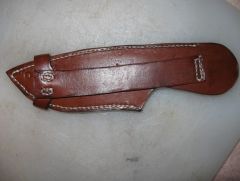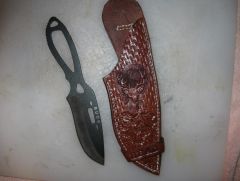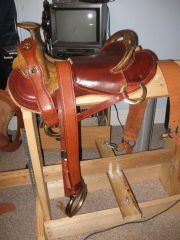
Skidder
Members-
Posts
40 -
Joined
-
Last visited
Content Type
Profiles
Forums
Events
Blogs
Gallery
Everything posted by Skidder
-
From the album: First Sheath
-
-
From the album: First Sheath
-
Always great to see beautiful work! Even better when it's something that everyone else isn't doing! That's the part of working with leather that keeps me going. Taking a vision you have in your head, and then seeing it become reality and really work. You know you're onto something when 20 years from now, people will spot it and know exactly who built it because it's a unique piece of art. Awesome!
-
Changing Out The Leather Strings On A Saddle
Skidder replied to helpinghorses's topic in How Do I Do That?
Once you determine how it's attached, one method I've used to replace them when through the skirt but under the fleece is to sew the new saddle string to the old then use the old to pull it through. Of course, this is assuming the old saddle string is in good enough shape and strong enough to pull on. One note of caution. Some saddlers glue the fleece to the skirt before sewing. If that's the case and you have to restitch it, you may have a mess on your hands. I'd be asking myself if I should replace the shearling while replacing the saddle strings. Odds are if the saddle strings are falling apart, the shearling is probably not in the greatest shape. Of course, at that point, it might be worth enlisting the help of someone who repairs saddles to make sure everything is sewn and fit properly once repaired. -
There are a number of things that can cause this. The obvious is the wrong tree. If you have sat in other saddles built on the same tree and length seat that feel more comfortable, you can possibly eliminate that. One area to evaluate is the seat itself. If you put in a ground leather seat and built it up too much in the back, then it can "push" you forward in the seat and over the stirrups too much. Pay close attention to how you shape your seat and test it out as you go along. Consider making a spare set of stirrup leathers you can set in place while building it and test the fit, then adjust the seat so it's comfortable. You shouldn't feel like you're sliding forward when you sit in it. At the same time, you don't want to create too much rise too far back because it restricts your movement too much and will be uncomfortable if you ride a long time. Much of this is determined by the shape of the rider as to what is comfortable, but the goal is to put the rider in the proper position, yet allowing them freedom of movement and comfort. If have a stand that keeps the saddle in the same relative position it will be on the horse, even better. Depending on how the drawdown stand is built, the front of the tree might sit lower than it would on a horse and throw you off when you sit in it to test how it feels. It's important to remember trees are not all equal with how the stirrup leather slots/channels are cut. Some are intentially designed to keep the stirrups under the rider more while others have a more forward position depending on intended use. If the stirrup leathers are properly positioned, there's probably not a lot you can do to alter the location of the stirrups significantly.
-
I haven't had a chance to ride it yet. I soaked and turned the stirrups so they were drying at the time I took the picture. I went with Oxbows to keep it old school looking, but might switch to bells later for comfort. The seat is comfortable on the stand, but I'll let you know if that changes once it's on the horse. Shouldn't really. I'm anticipating I'll have to be a bit more quiet in the seat since the skirts are minimal and normally a bit more prone to travel on a horse. I agree about synthetic trees. While they would work in this application since it will be used on the trails, I still prefer knowing there's a nice wooden tree under me. It also lends to the overall look of it. The pockets in the front and the way it's sewn in the back should be sufficient to prevent "curl". When I blocked the skirt, I didn't push it up around the tree from the bottom, rather down from the top. I wanted as much surface area as possible so by pushing it down, I avoided having to fill the skirt on the bottom side to make it more even with the tree.
-
From the album: Santa Fe Saddle
Built using Santa Fe tree. The saddle was built using a minimalistic approach for use on the trail. Seat was cut to be completely integrated with the skirt and hold it to the tree. Seat leather wraps completely around the back of the cantle and is sewn to the skirt to hold it in place. Since I don't cut my horse in two when cinching it up, I wasn't overly concerned with stretch. By the time I get done riding, I can usually fit a fist between the cinch and horse to give you an idea of how loose I ride it. Overall weight is right around 21 pounds and fenders might be added at a later date, but I wanted to ride it for a bit without them and I'm not too concerned about being pinched. The seat is a half seat with full leather and no strainer. Leading edge is sewn. All stitching is done by hand. The goal was to test the design/functionality versus creating a master piece to sell. Basically an experimental saddle with more emphasis on design possibilities than little details.© © Skidder 2010
-
-
Tandy sells small stitching ponies/horses and they're probably cheaper than the wood vise in the picture. The Stohlman book will be a great guide and I would venture to say, most people use his methods for most things. I'd avoid the speedy stitcher route, or drilling holes. The Stohlman book explains why the diamond awl is better. Sewing machines are great. I have a Tippman Boss, but still sew almost everything by hand. When I sew by hand, I know I'm not going to miss any stitches, or have any issues. I control the quality. Many will argue that with the right machine, you don't have to worry about any of that so it's preference. Some people prefer leather goods that are hand sewn. My personal OPINION is at some point you're going to have to hand sew. Learn how to hand sew first and once you can run stitches that look almost as good as machine sewn, then get a machine if you want. If you build saddles, you have to hand sew several parts. If you can't make the hand stitching look almost as good as machine sewn, it's really going to look like crap when you have a piece that's hand sewn next to something done by machine. I hand sew because I want to keep getting better and faster. I like the look of well sewn goods and there's something about something handsewn that says the maker was proud and cared. Look at saddles in the store that are mass produced and machine sewn. They cease to be a piece of "art". Of course there are a number of ways to do most things so it comes down to preference, opinion, and what you're goal is.
-
FYI - I've been working on building a stitching horse/pony for working on saddles. I want one that's versatile and will function as a saddle stand with an attachment for hand sewing. In my quest for parts and ideas, I came across a wood carving base that will rotate and tilt to almost any angle. The cool part is it has a flat top with slots where I can attach various items if I desire which means, I can build a piece to function like Stohlman's "Old George" and clamp saddles in it, or build a stitching pony/clamp to attach and hold leather at any angle as well. If anyone is interested, you can find the base through Rockler wood working supplies. If I get it worked out and put together, I'll post pictures of how I build it if anyone is interested as well.
-
One item I haven't seen posted, but have found out the not so pleasant way is make sure both sides of your stitching awl are equally sharp. If one side is dull and the other is sharp, it will/can throw the awl to the left or the right as you push it through the leather. This may or may not be an issue for your project, but it looks like garbage, particularly if you hold the awl in one direction and at some point, turn it 180 degrees. Now you have holes that were thrown to the right suddenly going to the left and your stitching line goes with it. Whoever posted the trick about running the awl across bee's wax, thanks! I find that makes about as much of a difference in pushing the awl through as stropping or anything else. Does a great job making it glide. Sew some 3/4" leather and you'll really appreciate the trick.
-
Watch out Amanda!! If you get bit by the bug, a wallet can turn into a saddle in no time!! I'm fairly new to all this, but if you don't want to spend a lot of money (easy to do), I know Tandy sells a basic set of 6 stamps/tools that will get you going. I used those for a while until I got a better understanding of how to work with leather. They sell a start kit that has everything you need, but it's just that.... for starting out. A lot depends on your goal, however, I wouldn't spend a lot of money on high dollar tools until you get proficient with the basics. I really wouldn't spend a lot on high quality leather at first. If you can find someone who has scrap, even better. Depending on what your goal is, beware that making even basic tack can quickly add up when it comes to buying various draw knives, round knives, and other tools. I see you're from Troy, MO which is just a short stretch down the road from where I am. Check out S T Leather in downtown St. Louis. There's a Tandy store out near Fenton. If you want to contact me, I can get you a bunch of scrap, and can probably find time to show you what I've got for making tack and such. ST Leather has almost every type of leather you can imagine, but they deal in overstock type stuff and get a lot of their stock from Tandy, but they're much cheaper. They also care a number of books and other reference material to include books by Stohlman.
-
Somewhere like the National Western Stock Show in Denver would be ideal. It's a huge event and while coupling the seminar with something like that, people would be more inclined to travel. I love your website and it's very informative. I also think a collaberative effort with a master saddler would also be great. I regularly run into discussions about "tweaking" trees by adding leather to accommodate irregularies in horses. It would be great to have a better understanding of what falls under the realm of the tree maker and the maker when designing a custom saddle. When to adjust. When not to. How to account for changes in a horse over its lifetime. For example, you're building a saddle for a 3 year old. How to you account for changes in it's body to give the longest use for the saddle without soring the horse.
-
Just my two cents. I've been getting into saddlery and a couple things I've learned rather quickly. Be careful about the school you choose. I have looked at a couple and some just want to cover the tree with leather and make it look pretty, but don't understand horses, their anatomy, or how to do a good seat. Depending on the school, you might be wasting time and money. Personally, if you can find a master maker who will show you the right way from the start as an apprentice, I would go that route. They can save you a lot of grief and you can gain invaluable experience. You can get a lot of cheap tools that will give you a chance to practice without a lot of cost up front, but it can show in the quality of your work. One way of getting better tools besides the second hand route is to do smaller projects such as wraps for beer mugs and such so you can practice, complete a lot of different projects, and then sell them and use the money to upgrade. I made a few for friends and was overwhelmed with requests from people wanting something special for someone. Tear apart any saddle you can. I have found a lot of people have old saddles they don't want, or that need repairs. I'll tear apart any useless saddle to see how it was built. I find there's as much knowledge in learning what doesn't work as there is in what does. Like Thomas Edison once said. "I've never failed. I've learned 10,000 things that dont' work." If a saddle failed, then pay attention to why. Was it the construction? Materials? It will help avoid making the same mistakes as others. I personally believe there hasn't been a lot that hasn't been tried and there's usually a pretty good reason why things are done the way they are. I found saddlery is a progression. While it would be great to turn out $50,000 saddles like Bill Maloy and others from the beginning, it's not realistic to expect to produce saddles on the same level as those with 50 years experience. In the beginning you'll probably have to build a lot of more basic saddles to keep the business going as your skills improve. In short, building saddles to sell. Over time and with a lot of dedication it will progress until your work is in demand and you're doing custom orders instead. Keep in mind, business is about supply and demand. The trick is finding the demand and one that's sustainable. While certain styles of tooling and saddles might be more appealing to you, it doesn't do any good if you can only sell one or two a year. It's not easy. You have to figure out what sells, develop the skills, and then find something unique in your products that everyone isn't doing. Don King is a perfect example with the Sheridan Style. If you can make your work recognizable, unique, and appealing to a large audience, then you're in good shape. I think that's the toughest part. With a lot of good carvers out there, particularly in this economy, it's tough to find that perfect combination. I'm still searching. One thing I'm always conscious of is others will see my work. That's the quickest way to sink or swim and your best advertisement. When I move to saddlery full time, I won't worry about selling on the web and want people to see my work in person so they know exactly what they're getting. It will allow me to get direct feedback, see what they're looking for, and help give my work a direction. I'm going to worry about a wider audience when I have a better understanding of what people expect, want, and are willing to pay. I don't want to send out something sight unseen to a customer to have them dissatisfied and worry about them telling others they're disappointed in the product. The other thing I'm finding is when you deal with people who are passionate about what they do, you have to be a bit careful. For example, if someone is hardcore into Wade style saddles with flat plate rigging, you can quickly push wrong buttons if you start talking about doing a Bowman with an in-skirt rigging. Personally, I want to learn how to do all the styles, even if I don't care for them, simply because I'm a firm believer that the more I know, the better it makes me. However, I have found many saddlers are willing to help you out, but they are just as quick to close the door if they feel they're wasting their time because you don't want to do things their way. Above all, practice. I have a very long way to go. If you look at the tools old timers used, a lot of them were nothing more than bolts they filed down and turned into tools, yet they produced amazing work. At the end of the day, it's not the arrow, it's the Indian. So, while having the best tools, taking classes, and all those other things can help make life easier, more efficient, and increase productivity, you're greatest investment.....and cheapest, is time spent practicing. Best of luck to you!




